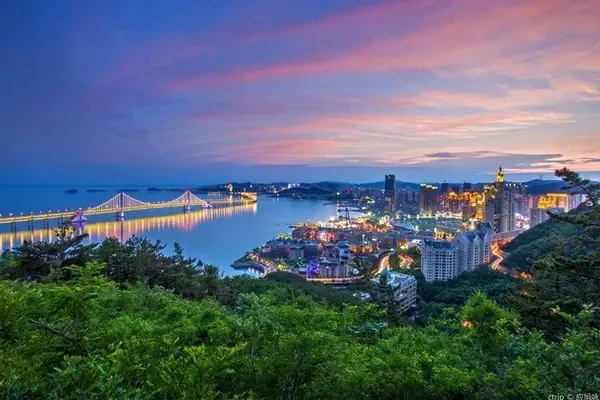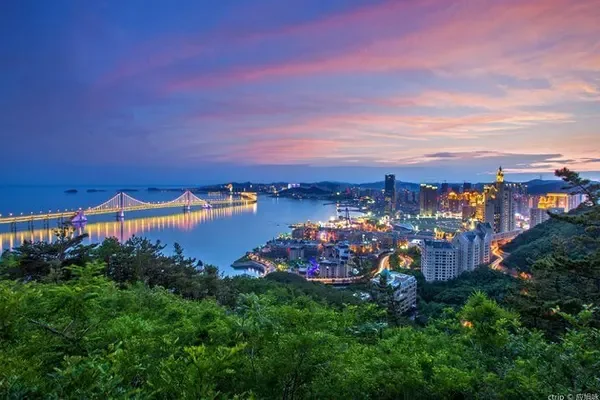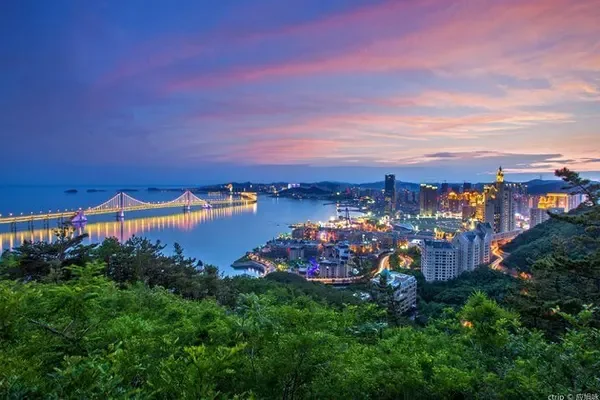
The spring breeze wakes up the 100,000 mu of wild apricot blossoms at the foot of the Jinshanling Great Wall. The blooming blooms and the undulating Great Wall extend to an unseen distance between the vast sky and the earth, forming a picture of the most beautiful spring in China. Scroll of Mountains and Rivers.
In the morning light, I followed the faint aroma of apricot blossoms, walked through the darkness, and arrived at the chaogoulou of the Jinshanling Great Wall. I strolled on the ancient Great Wall, touched the thick bricks, and waited quietly for the sun to pass through the continuous mountains. Jumping up, the air is the smell of silence, with a little bit of spring's bright breath. The Great Wall is meandering, the sunrise is brilliant, spring seems far away, and the apricot blossoms blooming above the Great Wall are full of fragrance.

In the spring when the apricot blossoms are blooming, walk into the Jinshanling Great Wall in Chengde, Hebei Province. The Jinshanling Great Wall is located in Luanping County, Chengde City, Hebei Province, adjacent to Miyun District, Beijing. It is only 130 kilometers away from downtown Beijing, and it is also the golden tourist destination in Beijing. Attractions, Jinshanling Great Wall was built by Qi Jiguang, a patriotic general of the Ming Dynasty, when he served as the general officer of Jizhen. It is also the essence of the Great Wall. It has the reputation of the Great Wall and the unique Jinshan.
Jinshanling in spring is full of vicissitudes. The winding Great Wall stretches among the high mountains. The afterglow of the setting sun casts a meaningful halo on the bricks of the ancient city of more than 400 years, elongating the silhouette of travelers. Jinshanling in spring is graceful and beautiful again. The wild apricot blossoms swaying in the spring breeze complement each other with the thick and ancient Great Wall, which is gorgeous and magnificent.

The Great Wall is thousands of miles long, and the outside of the Great Wall is the hometown. The Great Wall of China winds and undulates for thousands of miles. It played an important defensive role in the ancient cold weapon era, and also played a key defensive role for the ancients to resist foreign enemies in battle.
The Jinshanling Great Wall is the best preserved section of the Ming Great Wall. If you want to trace the history of the Jinshanling Great Wall, you have to start with Qi Jiguang, the chief soldier of Ji Town, a famous anti-Japanese general. At that time, Zhu Zaihou, Emperor Muzong of the Ming Dynasty, ascended the throne. He transferred the famous anti-Japanese general Qi Jiguang from the south to the north to build the Great Wall, which is the Jinshanling Great Wall we see now.

The brilliant blooming wild apricots and the ancient vicissitudes of the Great Wall complement each other beautifully. It is the best encounter this spring. The Jinshanling Great Wall is the essence of the entire Great Wall. It is connected to the Simatai Great Wall in the east and the Gubeikou Great Wall in the west. 10.5 km.
Along the Jinshanling Great Wall, there are 5 passes, 67 enemy towers, and 3 towers. The Jinshanling Great Wall has five characteristics, which attract countless Chinese and foreign tourists. The defense system is sound and well preserved, and it is famous all over the world.

When you come to Jinshanling Great Wall in spring, if time permits, you must remember to climb the Great Wall before sunrise to see a gorgeous sunrise on the Great Wall. In order to wait for the sunrise of the Jinshanling Great Wall, I started climbing from the foot of the mountain at four o'clock in the morning. When I stood quietly at the crenel of the city wall, looking at the rolling mountains in front of me, I was covered by the crimson morning light. When the picture was slowly dyed red, my heart was full of touch and joy.

The Jinshanling Great Wall in spring is gorgeous. The breeze gently shakes the blooming apricot blossoms. It seems to be singing a four-hundred-year-old song for everyone who stays. Jinshanling is 700 meters above sea level, and you can enjoy the scenery from different angles. It is also completely different. Climb to the highest point of the Great Wall and look to the north. The mountains are undulating like waves. To the east, you can see the Simatai Reservoir like a mirror, and to the south is the Miyun Reservoir, with sparkling blue waves. The Great Wall is surrounded by mountains and rivers, and it is a paradise for photography lovers.

The Jinshanling Great Wall has different scenery in four seasons and each has its own characteristics. Many travel enthusiasts and photographers will get completely different surprises when they come here in different seasons.
In spring, the mountain flowers are blooming and the apricot blossoms are fragrant. You can take pictures of the 100,000 acres of mountain apricot flowers and the Great Wall. The vast autumn scenery is exciting, and after the severe winter, the Jinshanling Great Wall is covered with silver and covered with snow, which is equally attractive. In Jinshanling Great Wall, there are beautiful scenery all year round.

The wonderful changes of nature endow Jinshanling Great Wall with different beauty in four seasons. There are also some professional Great Wall photographers in our country. The different charms of the ancient Great Wall in four seasons attract them to chase light and shadow again and again to record the Great Wall. The beauty of the four seasons.
At the foot of the Jinshanling Great Wall is Erdaoliangzi Village. The unique geographical environment has cultivated countless children who love the Great Wall. Some of them have become professional Great Wall photographers. , Some generations of grandparents and grandchildren have silently contributed to the protection of the Great Wall and become the guardians of the Great Wall. I like everyone who protects the Great Wall and records the Great Wall. They are the recorders of the Great Wall and the witnesses of history. By.

Experts call the Jinshanling Great Wall the essence of the Great Wall of the Ming Dynasty. Why there is a saying that the Great Wall is unique in Jinshan, it starts with the complexity of the construction of the Jinshanling Great Wall.
On the Jinshanling Great Wall, there are dense enemy towers, usually 50-100 meters high. For tourists, every time they arrive at each enemy tower, they will have a different feeling. The walls of the enemy towers are based on boulders and are 5-8 meters high. Various forms, each with its own characteristics. There are brick and wood structures, masonry structures, single-story ones, and double-layer ones. There are flat roofs, dome roofs, boat roofs, square-drilled zeniths and octagonal caisson roofs. It can be said that the first floor has one style. , so the Jinshanling Great Wall is known as "the Great Wall of Ten Thousand Miles, the only beauty in Jinshan".

Every year in early April, the wild apricot flowers on the Jinshanling Great Wall bloom, which is also the time when the Jinshanling Apricot Blossom Festival is held. This year’s Apricot Blossom Festival, due to special reasons, the Jinshanling Great Wall specially held the form of cloud tourism and cloud flower appreciation. Through the form of live broadcast, everyone can still see the beautiful picture of apricot blossoms blooming on the Great Wall at home.
On the Great Wall, a woman in an ancient costume twirled lightly and slowly, and played a zither, bringing people to a quiet and distant realm. In an instant, time travels through a hundred years.

The smiling faces of apricot blossoms, under the blowing of the spring breeze, are as bright as clouds, fragrant the spring of Jinshanling Great Wall.

Every year at the Apricot Blossom Festival, there will be different performances on the Jinshanling Great Wall to celebrate the arrival of spring. Listening to the zither, admiring flowers and drinking tea are also one of the joys in life.

Tai Chi is an important concept in the history of Chinese Taoist culture. Tai Chi, Tai Chi Sword and Tai Chi Umbrella performances with unique Chinese charm are especially different when performed on the Great Wall. The movement of flowing clouds and flowing water is full of Zen.
Performing Tai Chi on the Great Wall is a group of retired aunts. They love Chinese culture and Tai Chi’s way of health preservation. When chatting with one of the aunts, I know that the Jinshanling Great Wall has held eight Apricot Blossom Festivals, except for one They didn't come, and they participated in the seven consecutive Apricot Blossom Festivals.

From the perspective of aerial photography, the Jinshanling Great Wall is more majestic, precipitous, beautiful and verdant. As a part of the Great Wall, it was listed as a world cultural heritage in 1987 and included in the third batch of national key cultural relics protection units in 1988. Jinshanling Great Wall is also a national-level scenic spot and a national 4A-level tourist attraction. "Jinshanling-Simatai Great Wall" was rated as the seventh of China's top ten autumn colors by the 11th issue of "China National Geography" in 2010. After seeing the Jinshanling Great Wall in spring, I am looking forward to it again in autumn.

Standing far away on the viewing platform, the swaying and fragrant red apricots bloom in front of you, and the rolling mountains are in the distance. At this time, I deeply feel my own insignificance.
According to the research of cultural relics experts, as early as the Northern Qi Dynasty, the Great Wall was built and fortifications were set up in this area. But at that time, due to limited conditions, the Great Wall was low and thin, mostly made of earth and rocks. It was not until the Ming Dynasty that Qi Jiguang began to rebuild the Great Wall.

After Qi Jiguang took office, he began to climb up to inspect the Great Wall. After observation, he found that the original Great Wall was low and thin, and many places had collapsed and could not play its role in defending against the enemy. Therefore, Qi Jiguang asked the imperial court to agree, and with the strong support of Tan Lun, governor of Ji, Liao and Bao, the original Great Wall of more than 1,200 miles long under the jurisdiction of Ji Town was generally rebuilt and rebuilt. The Jinshanling Great Wall we see now, when we climb the Great Wall, we will see the statue of General Qi Jiguang on the Great Wall.

The scenery of the Great Wall is different in four seasons, and the viewing platforms for shooting sunrise, sunset and sea of clouds are also different. Experienced Great Wall photographers, after years of accumulation, have a clear understanding of the different natural phenomena in different seasons on the Jinshanling Great Wall. They love the Great Wall, and this deep love is reflected in the beautiful photos.

The profound historical and cultural heritage endows the Jinshanling Great Wall with vicissitudes of beauty. Barrier walls, text bricks and horse-blocking stones are the three unique features of the Jinshanling Great Wall. If you have enough time, it is recommended to stay here for two days for a more in-depth tour. Enjoy the sunrise and moonset of the Great Wall.

When the sun sets, the warm yellow halo sprinkles on the ancient city bricks. At the end of the field of vision, the silhouette of the apricot tree swaying in the spring breeze. Such beauty makes people mesmerized.

Many people are familiar with the Jinshanling Great Wall from the news broadcast. When the national anthem is played, the Great Wall that appears on the screen is the Jinshanling Great Wall. On November 15, 1992, Ke Shouliang, the "flying man" in Asia, drove a motorcycle The car successfully flew over the Jinshanling Great Wall, leaving a strong mark in the long years of the Great Wall.

The Great Wall is an ancient defense project with the longest construction time and the largest amount of construction in China and the world. In the history of China's 5,000-year civilization development, the Great Wall has been built for more than 2,000 years. The Great Wall of all dynasties adds up , is about 50,000 kilometers, so there is a saying that it lasts two thousand years, and it is more than 100,000 miles in length and width. Such a huge project is unique not only in China, but also in the world. Therefore, many international friends, when it comes to China, The first thing that comes to mind is our Great Wall.

When visiting cultural relics and historic sites, we will have a deep admiration for the wisdom of the ancients. There are many details on the Great Wall. If we pay attention, we will find that when the ancients built the Great Wall, they designed many ingenious designs according to the needs of war. The place.
There is a small hole on the crenel of the Jinshanling Great Wall. At the beginning, I didn’t pay attention to it. After listening to the locals, I realized that this small hole played a great role in resisting foreign enemies. There are two kinds of small holes. Uses: First, the Ming Dynasty introduced a weapon called the Frangler from foreign countries. There is a shaft under the Frangler, and the shaft is inserted into a small hole, which can be rotated to shoot in a fan shape. The second is to insert the military flag to cheer, or use the flag as a signal to convey the enemy's situation.

Strolling on the meandering Jinshanling Great Wall, the breeze blows, bringing a faint fragrance of apricot blossoms, and the setting sun casts warm colors on the distant mountains and towers. The scenes of battles of gold and iron horses roaring like clouds in the past have become a rich and colorful stroke in the history books. The Jinshanling Great Wall in spring has ancient rhymes, flowing into rivers and mountains for thousands of miles in the bottom of my heart.



